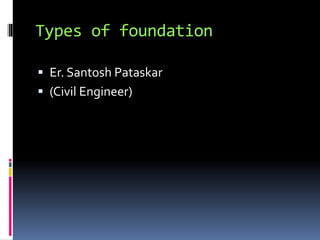
pptsantosh-141119034508-conversion-gate01.ppt
- 1. Types of foundation Er. Santosh Pataskar (Civil Engineer)
- 2. FOUNDATION
- 3. Content: Objectives and function of foundation Materials used for foundation Types of foundation
- 5. Foundation Design Principles The main objectives of foundation design are to:- ensure that the structural loads are transmitted to the subsoil safely, economically and without any unacceptable movement during the construction period and throughout the anticipated life of the building or structure
- 6. Basic Design Procedure Assessment of site conditions in the context of the site & soil investigation report Calculation of anticipated structural loading Choosing the foundation type, should consider: • Soil condition • Type of structure • Structural loading • Economic factors • Time factors relative to the proposed contract period • Construction problem Sizing the chosen foundation in the context of loading, ground bearing capacity & any likely future movement of the building / structure
- 7. Functions of foundation 1. Distribution of loads 2. Stability against sliding & overturning 3. Minimize differential settlement 4. Safe against undermining 5. Provide level surface 6. Minimize distress against soil movement
- 8. Distribution of loads Foundation help to distribute the loads of super- structure to a large of the soil Therefore, the intensity of load at its base does not exceed the safe bearing capacity of the soil In the case of deep foundations, the super imposed loads are transmitted either through end bearing or both by side friction & end bearing FUNCTIONS OF FOUNDATION
- 9. Stability against sliding & overturning Foundation imparts lateral stability to the super structure by anchoring it to the ground It increases the stability against sliding & overturning due to horizontal forces to wind, earthquake, etc. FUNCTIONS OF FOUNDATION
- 10. Minimize differential settlement Foundation distribute the super-imposed loads evenly on the sub-soil, even in the case of non- uniform loads This can be achieved by constructing combined footing or raft foundation FUNCTIONS OF FOUNDATION
- 11. Safe against undermining Foundation provide safety against scouring or undermining by flood water or burrowing animals FUNCTIONS OF FOUNDATION PROVIDE LEVEL SURFACE It provides level surface over which super- structure can be raised
- 12. Minimize distress against soil movement Distress or failure due to expansion or contraction of the sub-soil due to moisture variation in clayey & black cotton soils are minimized by the provision of special type foundations FUNCTIONS OF FOUNDATION
- 13. Types of foundations TYPES OF FOUNDATIONS PAD FOUNDATION RAFT FOUNDATION STRIP FOUNDATION PILED FOUNDATION
- 14. PAD FOUNDATION Suitable for most subsoil except loose sand, loose gravels and fill areas Usually constructed of reinforced concrete, square in plan Typical pad foundation types are: Isolated or pad foundation Steel grillage Rectangular pad Combined column foundation
- 15. Strip foundation Suitable for most subsoil & light structure loadings Suitable for those encountered in low to medium rise domestic dwellings where mass concrete can be used Typical strip foundation types: Traditional strip Deep strip or trench fill Reinforced concrete strip Continuous column
- 16. Raft foundation Used to spread the load of the structure over a large base to reduce the load per unit area being imposed on the ground Particularly useful where low bearing capacity soils are encountered & where individual column loads are heavy Typical raft foundation: Solid slab raft Beam & slab raft
- 17. Pile foundation Can be defined as a series of columns constructed or inserted into the ground to transmit the loads of a structure to a lower level of subsoil Can be used when suitable foundation conditions are not presented at or near ground level Classification of piles (may be classified by their basic design function or method of construction): • End bearing piles • Friction or floating piles • Replacement piles • Displacement piles
- 18. Materials used for foundation Foundation must be constructed of a durable material of an adequate strength The most suitable material is concrete Concrete is a mixture of cement, aggregates & water in a controlled proportion
- 19. Cement Manufactured from clay & chalk Act as a binder of the concrete mix Cement can be supplied in bags ( 1 bag = 50kg) or in bulk Air tight sealed bags requiring a dry dump free store Bulk cement delivered by tanker (12 to 50 tonnes) & pumped into storage silo
- 20. Aggregates 2 types of aggregates: coarse & fine aggregates Coarse aggregate is defined as a material which is retained on a 5mm sieve Fine aggregate is defined as a material which is passes a 5mm sieve Aggregate can be either : Natural rock which has disintegrated Crushed stone gravels
- 21. Water Must be of a good quality fit for drinking Water is added to start the chemical reaction & to give workability The amount of water used is called the water/cement ratios, usually about 0.4 to 0.5 Too much water will produce a weak concrete mix of low strength Whereas too little water will produce a concrete mix of low & inadequate workability.
- 22. Concrete mix This concrete mix expressed as a ratio, e.g., 1:2:4 or 1:3:6/20mm, which means 1 part of cement 3 parts of fine aggregates 6 parts of coarse aggregate 20mm – maximum size of coarse aggregate for the mix
- 23. Er.SANTOSH PATASKAR (9098445611) It is a different types of foundation for construction work. THE END